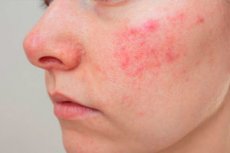Study Finds Significant Link Between Rosacea and Malignant Melanoma
Last reviewed: 14.06.2024

All iLive content is medically reviewed or fact checked to ensure as much factual accuracy as possible.
We have strict sourcing guidelines and only link to reputable media sites, academic research institutions and, whenever possible, medically peer reviewed studies. Note that the numbers in parentheses ([1], [2], etc.) are clickable links to these studies.
If you feel that any of our content is inaccurate, out-of-date, or otherwise questionable, please select it and press Ctrl + Enter.

A recent study published in Scientific Reports found that rosacea, a common skin condition usually considered only a cosmetic problem, may be associated with several underlying conditions, including: including melanoma.
The study used a large age- and sex-matched cohort obtained from the TriNetX platform (n = 244,888), including representatives of Caucasian, Black, Asian, Alaskan, and Pacific Islander ethnic groups.
The study results show that, contrary to previous studies, rosacea is significantly associated with an increased risk of visual disturbances, metabolic disorders, joint problems and type 2 diabetes (T2D).
It is particularly notable that the Caucasian subgroup showed a significantly increased risk of melanoma, which was not present in the Asian subgroup. These ethnic differences may explain conflicting reports of comorbidities in previous studies.
Despite the notable limitations of the retrospective study design, it justifies the need for further research into the pathology of this common but poorly understood disease.
What is rosacea and why has it remained out of sight of epidemiologists for a long time? Rosacea is a chronic skin condition that predominantly causes redness and rashes on the cheeks, chin, nose and forehead in affected individuals. This condition is most common in women aged 30-50, although it can occur in people of any age and gender.
Worldwide reports indicate that people of Celtic descent and fair-skinned northern Europeans are more vulnerable to the disease, with prevalence estimated to be between 5 and 10% among these ethnic groups, compared with a global estimate of 1 to 7%.
Although rosacea was described as early as Geoffrey Chaucer's The Canterbury Tales in the late 1300s and possibly as early as 200 B.C. Theocritus, it still remains poorly understood.
Although numerous causes have been proposed for the disease, including ultraviolet exposure, smoking, alcohol, heat, exercise, psychological stress and, most often, genetics, these causes have never been scientifically proven.
Recent studies have linked infections with Demodex species to the manifestations of rosacea, leading to oral antibiotics becoming the clinical intervention of choice when symptoms occur. However, these interventions provide only temporary relief, and there is currently no long-term cure for this disease.
The present study aimed to retrospectively use data from a large "real-world" database (TriNetX platform) to identify possible correlations between rosacea and several systemic diseases, including malignancies.
Data were obtained from 21,913,235 enrolled TriNetX patients between June and July 2023 and included both demographics (specifically age, gender, and ethnicity) and medical records (diagnoses, medications, laboratory observations, and genomic information).
Inclusion criteria for the study included patients diagnosed with International Classification of Diseases and Related Health Problems (ICD-10) code L71 (rosacea) and an equal number of age- and sex-matched patients without a diagnosis of rosacea included as controls.
Of the 132,388 patients diagnosed with ICD-10 code L71 (rosacea), 122,444 (69.2% women) had age- and sex-matched patients without a diagnosis of rosacea and were included in the present study. Of these, 82% were Caucasian, 3% were Black, 1.6% were Asian, 10% were unknown, and the remainder were Alaskan, Indian, Hawaiian, or Pacific Islander.
"While the odds ratio for a vascular disease diagnosis was 0.185 in patients without rosacea, this risk increased to 0.336 in patients with rosacea [OR 2.234 (2.192, 2.276)]."
In contrast to previous reports, rosacea was found to be associated with significantly increased risks of heart disease (OR = 1.649), type 2 diabetes (T2D; OR = 1.618), metabolic disease (OR = 3.165), and eye or joint disease (OR = 4.164-4.801).
Of greatest concern were comorbidities, most strongly associated with rosacea, including skin neoplasms (including malignant melanoma; OR = 6.031).
"In a subgroup analysis of rosacea patients with skin neoplasms, we were able to identify not only an increased risk of non-melanoma skin cancer [C44; OR 5.550 (5.345, 5.763)] but also malignant melanoma (C43) [OR 4.468 (4.144, 4.818)]. Given the sharply increased risk of malignant melanoma in our rosacea population, we performed a Kaplan–Meier survival analysis for this subgroup of patients. The survival probabilities at the end of the time window were 92.51% and 97.71% for the cohort with and without rosacea, respectively. With an HR of 3.286 (95% CI 3.101, 3.481), mortality was higher in patients with malignant melanoma if they also had rosacea (p = 0.059)."
In summary, this study convincingly links rosacea for the first time with multiple comorbidities, some of which (melanomas and heart disease) are life-threatening.
Despite the notable limitations of using only retrospective data and ICD-10 codes, the study highlights the importance of rosacea and the need for further research on this deceptively harmless disease.
